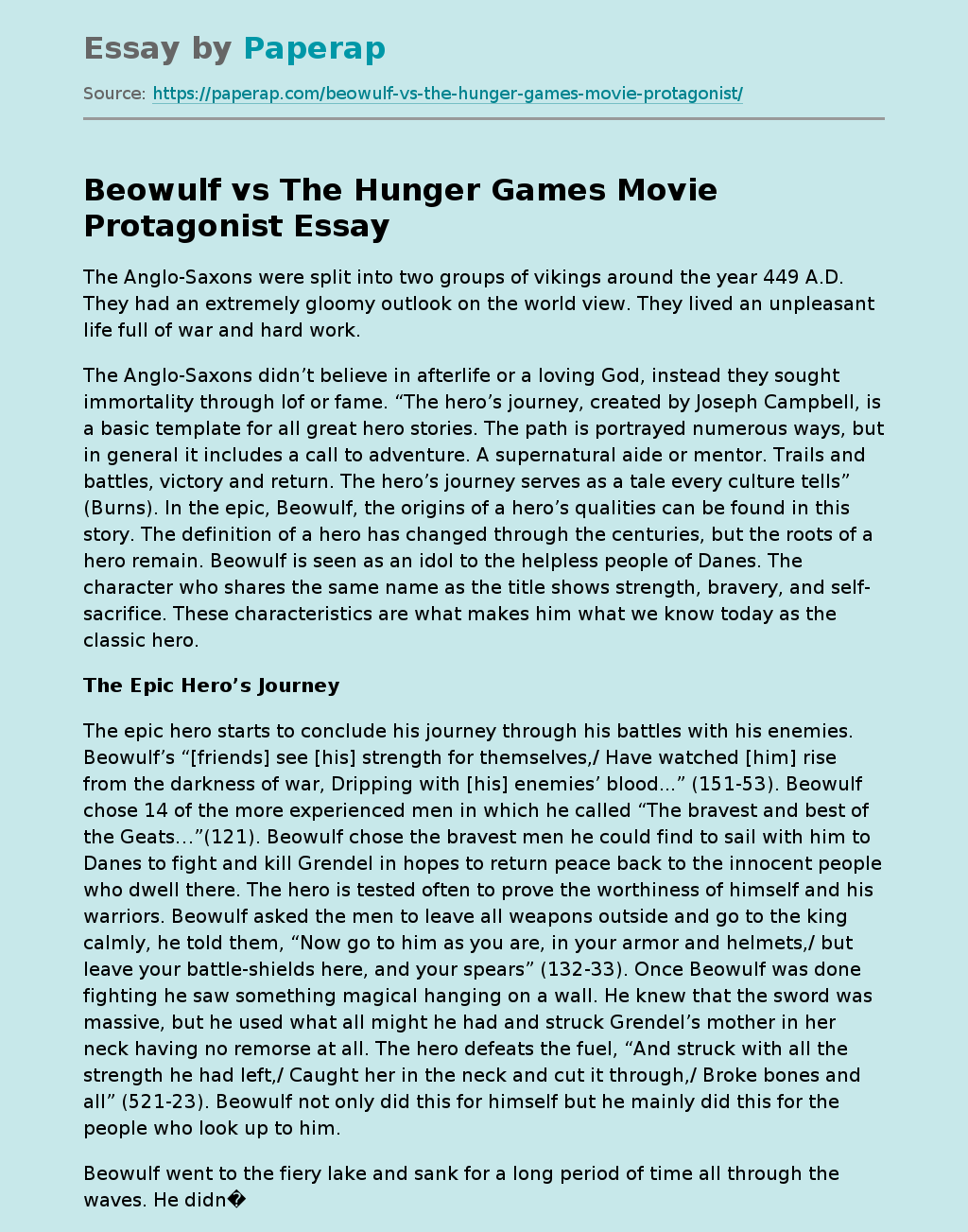Beowulf vs The Hunger Games Movie Protagonist
The Anglo-Saxons were split into two groups of vikings around the year 449 A.D. They had an extremely gloomy outlook on the world view. They lived an unpleasant life full of war and hard work.
The Anglo-Saxons didn’t believe in afterlife or a loving God, instead they sought immortality through lof or fame. “The hero’s journey, created by Joseph Campbell, is a basic template for all great hero stories. The path is portrayed numerous ways, but in general it includes a call to adventure.
A supernatural aide or mentor. Trails and battles, victory and return. The hero’s journey serves as a tale every culture tells” (Burns). In the epic, Beowulf, the origins of a hero’s qualities can be found in this story. The definition of a hero has changed through the centuries, but the roots of a hero remain. Beowulf is seen as an idol to the helpless people of Danes. The character who shares the same name as the title shows strength, bravery, and self- sacrifice.
These characteristics are what makes him what we know today as the classic hero.
The Epic Hero’s Journey
The epic hero starts to conclude his journey through his battles with his enemies. Beowulf’s “[friends] see [his] strength for themselves,/ Have watched [him] rise from the darkness of war, Dripping with [his] enemies’ blood…” (151-53). Beowulf chose 14 of the more experienced men in which he called “The bravest and best of the Geats…”(121). Beowulf chose the bravest men he could find to sail with him to Danes to fight and kill Grendel in hopes to return peace back to the innocent people who dwell there.
The hero is tested often to prove the worthiness of himself and his warriors. Beowulf asked the men to leave all weapons outside and go to the king calmly, he told them, “Now go to him as you are, in your armor and helmets,/ but leave your battle-shields here, and your spears” (132-33). Once Beowulf was done fighting he saw something magical hanging on a wall. He knew that the sword was massive, but he used what all might he had and struck Grendel’s mother in her neck having no remorse at all. The hero defeats the fuel, “And struck with all the strength he had left,/ Caught her in the neck and cut it through,/ Broke bones and all” (521-23). Beowulf not only did this for himself but he mainly did this for the people who look up to him.
Beowulf went to the fiery lake and sank for a long period of time all through the waves. He didn’t wait for anyone’s response and “…For hours he sank through the waves;/ At last he saw the mud of the bottom” (452-53). The hero travels to a paranormal world often one that humans beg for. Beowulf’s cycle finally reaches a low point but the hero never once gives up on his guest, “…Flames beat at the iron/ Shield, and for a time it held, protected/ Beowulf as he’d planned; then it began to melt”(665-67). His weapons fell and he could no longer fight the dragon and soon after that Beowulf reached his death. Beowulf returns to the mead-hall gaining his place on the throne, and “To salute him and show Grendel’s head./ [Beowulf] carried that terrible trophy by the hair,” (601-02). It was a awkward moment but such great sight, all of the people cheered.
Katniss Everdeen’s Similarities to Beowulf
Katniss Everdeen is viewed as a hero in the Hollywood famous movie, The Hunger Games. Like Beowulf she stands up for those who are voiceless and powerless. Being brave and selfless are characteristics of a hero. Heroes have been looked up to for centuries. People take comfort in others who they feel fight to protect them no matter what. Beowulf and Katniss Everdeen are different in ways but they share this God like quality in the same manner.
Beowulf vs The Hunger Games Movie Protagonist. (2021, Nov 17). Retrieved from https://paperap.com/beowulf-vs-the-hunger-games-movie-protagonist/

